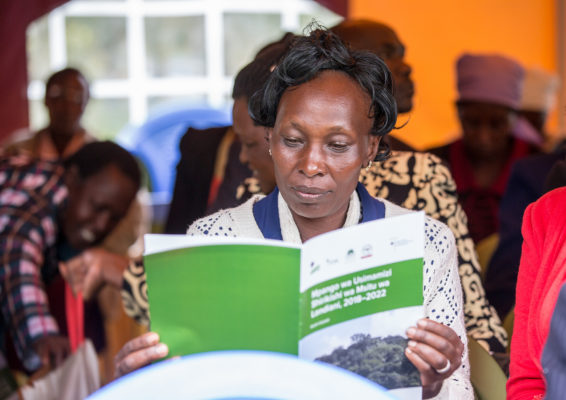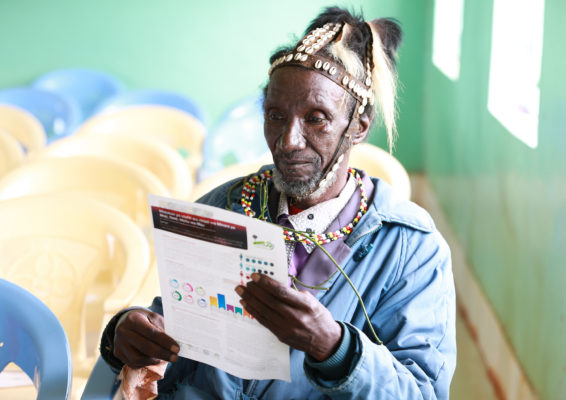Shaking up participation patterns
If governance collaboration is a win, then so is local buy-in. ‘Community participation’ has become something of a buzz-phrase internationally, and a cornerstone of Kenya’s forest management in recent years . Still, the research process has remained extractive, and those who sign up to take part miss out on the opportunity to learn .
In Londiani and Itare-Chemosit, by contrast, CIFOR staff facilitated thorough community feedback sessions before launching the new plans. Many participants found the practice surprising. “The management plan that we made in 2011,” described Inyambula, “we found it in the WRMA [water resource management authority] offices after demanding for it. As much as we make these documents, it’s not normal for people to come and launch them.”
The project also provided an opportunity to challenge entrenched gender norms. In the Rift Valley region, most communities are known to be very patriarchal, which impacts on forest and water management. Afterall, women are the main collectors of water and fuelwood for family use, and their frequent visits to the forest give them special knowledge of how to manage these resources sustainably.
“Excluding women from management and leadership locks out an important source of information and experience,” explains CIFOR Principal Scientist Esther Mwangi. With this in mind, both women and men have been trained in not only the links between forests and water, but also the gender differences in dealing with these resources: leadership, rights, access and decision-making being the four areas of focus.
The work has not been without pushback: in one case, a trainee who went on to educate others about conservation and gender issues was even assaulted by other women in her community. However, there is evidence that the work is beginning to prompt some shifts in gender relations. Women have been encouraged and facilitated to take on leadership roles in the CFAs and WRUAs, and they now lead three of the ten user groups in Itare-Chemosit. Some men are also beginning to make more space for women to work outside the home.
Community member flicks through the new integrated water and forestry plans
Village elder reading the Itare-Chemosit Sub-Catchment Management Plan (SCMP)
Violet Atieno/CIFOR
Scaling up
Participatory governance “is the future of forestry in Kenya,” said Boniface Mulwa, Assistant Ecosystem Conservator for the Kenya Forest Service (KFS), gesturing to one of the well-managed community forests in the Itare-Chemosit sub-catchment..
What, then, is required to make this future a reality? Inyambula highlighted the importance of political will to keep the collaborative, participatory approach going. “This will be successful only if the leaders want to make this union last,” he said. “We are humans: I am in power today, and my successor may not like the union.”
Clear tenure rights for communities living in and around forests are crucial to scaling up, said Chrispinus Wafula, a sub-catchment manager with the Water Resources Authority. “Some [political actors] are saying we need to resettle people in the forest, and others are saying they need to be evicted from the forest,” he said. “And this is having a big impact on efforts to conserve the water resources.”
Elizabeth Wambugu, who is the head of forest management planning at KFS, emphasized that participatory forest management relies on community members being motivated to contribute to conservation: and that this does not happen unless they can see how doing so connects with their own lives and personal goals.
“So the first thing is to create awareness about whatever they’re doing inside or outside of the forest,” said Wambugu, before expanding on how those activities are impacting on the ecosystem, as well as their own futures. “When we link it to their productivity,” she said, “they are more able to wait for the positive benefits as time goes on.”
Establishing alternative, low-impact livelihood strategies is important because of the short-term economic pressures of poverty, “which make it tempting for locals to cut down trees for charcoal and other uses”, said Wafula. In Londiani, for example, community members have begun producing honey, which they sell locally. They’re now working on improving their packaging so they can add value and sell it for higher prices in bigger markets. Eco-tourism is another potentially viable option to build livelihoods and encourage locals to leave the forest intact.
What’s exciting, said Wambugu, is that the projects’ success is starting to speak for itself, and the news is beginning to spread within the region. “The neighbouring station [to Londiani] is now saying they want to do the same,” she said, “so now it’s just about finding the funding to do it.”
Despite the challenges, Wafula remains optimistic that if appropriate participatory management plans are effectively implemented in the Rift Valley’s water towers and beyond, “we’ll improve both the water and forest resources, and we should have enough water to sustain people upstream and downstream.”
This will require engaging community stakeholders and indigenous knowledge-holders as well as professionals in the forest, agricultural and water sectors. “If we pool all that knowledge and we work together,” he said, “I’m very sure that we’ll succeed.”
This story is the first in a three-part series.
This research was supported by German Federal Ministry for Economic Cooperation and Development (BMZ).
Copyright policy:We want you to share Forests News content, which is licensed under Creative Commons
Attribution-NonCommercial-ShareAlike 4.0 International (CC BY-NC-SA 4.0). This means you are free to redistribute our material for non-commercial purposes. All we ask is that you give Forests News appropriate credit and link to the original Forests News content, indicate if changes were made, and distribute your contributions under the same Creative Commons license. You must notify Forests News if you repost, reprint or reuse our materials by contacting
forestsnews@cifor-icraf.org.

